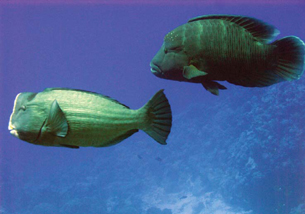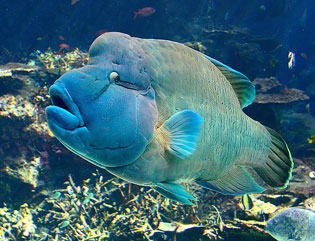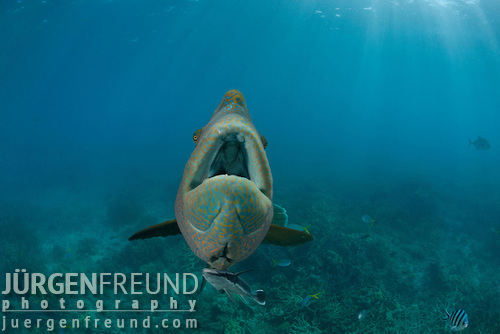Form and Function
GENERAL SHAPE
The form of the Napoleon Wrasse is
pretty typical of the average oceanic fish image
ingrained in our heads, but it has some interesting
quirks. In general, the Labridae family is formed
primarily for propulsion, or “labriform locomotion”
(Encyclopedia of Earth 2012). Typically, the Napoleon
Wrasse only treads with their pectoral fins in the open
water, only using the caudal fin, or tail, when a fast
burst is required, according to the Encyclopedia of
Earth (2012). The morphology of the Labridae family has been
evolved for the most efficient movement through water.
This species in particular is the largest
member of the Labridae family, for a glimpse of other types of
wrasses view
EOE's website (Encyclopedia of Earth 2012). The
largest recorded length of a Napoleon or Humphead Wrasse is 6 feet
according to NOAA, although females rarely surpass 36 inches (Bester
2013). Humphead are more commonly found around 24 inches at 5-7
years old, even though they can miraculously live to at least 30
years of age (Bester 2013). Their immense size causes a decrease in
natural predators, but longevity still seems hard to achieve due to
the increasing destructive fishing techniques, live reef food fish
trade, and many other factors according to the NOAA (2009). An
interesting study was done showing that, especially in
males, rapid growth rates are linked to relatively high
mortality rates in larger reef species (Ackerman et al. 2006). This correlates with wrasse
as they have a slow growth rate and increased longevity (Bester
2013).
or Humphead Wrasse is 6 feet
according to NOAA, although females rarely surpass 36 inches (Bester
2013). Humphead are more commonly found around 24 inches at 5-7
years old, even though they can miraculously live to at least 30
years of age (Bester 2013). Their immense size causes a decrease in
natural predators, but longevity still seems hard to achieve due to
the increasing destructive fishing techniques, live reef food fish
trade, and many other factors according to the NOAA (2009). An
interesting study was done showing that, especially in
males, rapid growth rates are linked to relatively high
mortality rates in larger reef species (Ackerman et al. 2006). This correlates with wrasse
as they have a slow growth rate and increased longevity (Bester
2013).
 HUMP
HUMP
Pertaining to the common name, Humphead Wrasse, these fish develop a
large hump on the back of their neck as they get larger. In the
“supermales” mentioned in the reproduction page, they show a more
prominent hump then most, according to Bester from Ichthyology at
the Florida Museum of Natural History (2013). It is possible that
this is due to sexual selection since it occurs more so in the
largest, most dominant individuals. In addition to the larger hump,
in chief males there is also a more vibrant coloration in the
patterns of the face (Bester 2013). This could reveal sexual
selection trait or a developed characteristic with size.
More specifically, Napoleon Wrasse have a perfectly evolved type of
jaw for their prey, sea stars and
brittle stars,
shrimp, clams,
snails,
crabs, and
fish, this wrasse
also consumes toxic animals such as sea urchins and the
crown-of-thorns
sea star,
along with many others (Shedd
Aquarium 2006). Their jaw comes equipped![]() with thickly padded lips to absorb the spines of the wrasses' more difficult prey like the sea urchins
and crown-of-thorns star, comparable to the
parrotfish (Shedd Aquarium 2006). Along with their lip
adaptations, Napoleon Wrasse also have pharyngeal teeth,
with thickly padded lips to absorb the spines of the wrasses' more difficult prey like the sea urchins
and crown-of-thorns star, comparable to the
parrotfish (Shedd Aquarium 2006). Along with their lip
adaptations, Napoleon Wrasse also have pharyngeal teeth, comparable
to molars that are teeth set deep in their throat which helps crush
hard organisms (Shedd Aquarium 2006). Apparently, divers have
reported even hearing the crunching and observing the particles from
the destruction of these hard shells near Napoleon Wrasse (Bester
2013).
comparable
to molars that are teeth set deep in their throat which helps crush
hard organisms (Shedd Aquarium 2006). Apparently, divers have
reported even hearing the crunching and observing the particles from
the destruction of these hard shells near Napoleon Wrasse (Bester
2013).
To prevent prey from escaping, the wrasse can
even expand their jaws ahead of their nose so they can pull prey out
of various crevices, caves, and holes in the reef, according to the Shedd
Aquarium (2006). If that wasn’t incredible enough, there are more
behavioral adaptations in response to mouth form! The Napoleon
Wrasse can also bite off coral coverings concealing their prey and
even blow jets of water at the sand to expose any organisms within
(Shedd Aquarium 2006). I wouldn’t want to be the prey of this
predatory fish because the Napoleon Wrasse is impressively formed in
reaction to its needs from evolution over time.
Click
here to see a video representation
from Carl Chapman of the Napoleon Wrasse form
and function in their natural environment. Note the morphology and
what adaptations it has evolved.
Check out our
References!
Back to
Homepage